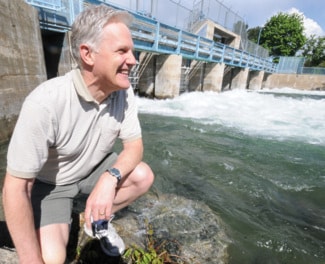Water levels in creeks and lakes around the South Okanagan are rising as the region experiences a strong freshet, but the recent spate of warm days isn’t causing much concern for officials watching the situations.
“It could be a concern in some areas, but generally speaking the types of temperatures we are seeing aren’t exceptional,” said Brian Symonds, director of regional operations for Water Stewardship B.C. “Fortunately, at least in some of the lower elevations, we have seen some more gradual melt going on and it has moved the snow out of there.
“But the mid to higher elevations still have a fair amount of snow remaining in those snowpacks and so the forecasts that I have seen suggest that we are going to see that start moving, but not persisting long enough at this point to really cause major concerns.”
Symonds warns, however, that the flooding warning issued last week is still in effect.
“I don’t want to say there isn’t a risk, because there is a risk at this time of year. We are going to be monitoring it very closely … in particular as we go through this next weekend, to see how some systems respond,” he said.
Most water systems in the area have been rising, he said, though that is changing in some areas.
“They have been sort of levelling off and in some cases declining over the last few days,” he said, noting there has also been gradual declines in the flows in some streams and rivers. “We’re going to be watching them, particularly some of the larger ones, because those are the ones that are fed from higher elevations, like the Similkameen and the Kettle.”
The heightened state of readiness will continue according to Symonds, who added that high water in streams has resulted in the need for sandbagging.
“There was some localized flooding of smaller creeks,” he said, referring to Wolf Cub Creek near Oliver, where sandbags had to be brought in. McDougall and Priest Creeks in the Central Okanagan also experienced flooding.
“Those are typical of ones that come from the lower to middle elevation. That was that first flush of snow, so those have already started to drop off,” said Symonds.
However, he stressed, the high snow pack at higher elevations could still cause flooding problems, and the warning for the public to take precautionary and safety measures around area lakes and rivers is still in effect.
“We’re into that critical period over the next few weeks. I don’t know that what we are seeing in the short term here is going to be as bad as what it could be.”
The Regional District of Okanagan Similkameen has also posted resources online outlining how to correctly use sandbagging, which they refer to as one of the most versatile flood fighting tools and a simple effective way to prevent or reduce flood water damage.
Information like the U.S. Army Corps of Engineers Sandbagging Techniques booklet and Safe Sandbagging – Work Safely to Avoid Injury are available through the Hot Topics section of the RDOS website at www.rdos.bc.ca.
Sandbags are available at locations throughout the Regional District of Okanagan-Similkameen, including the Naramata, Tulameen and Summerland fire halls and Keremeos, Oliver, Osoyoos, Penticton and Princeton public works yards.
